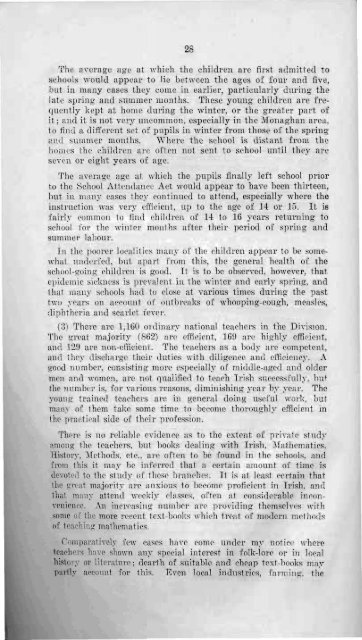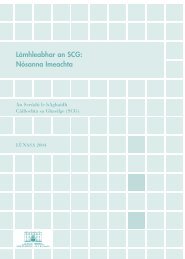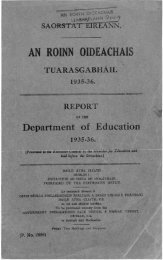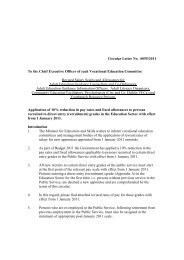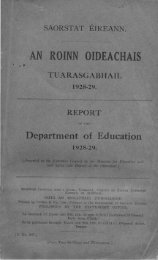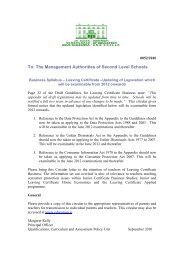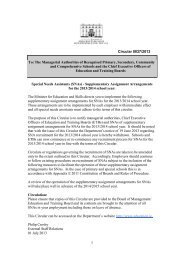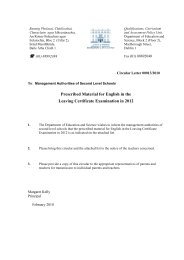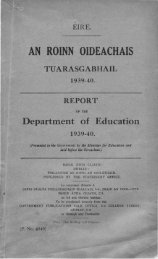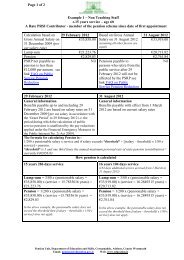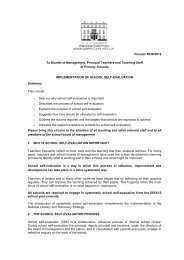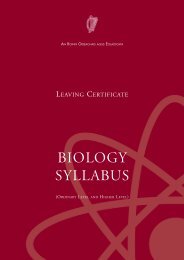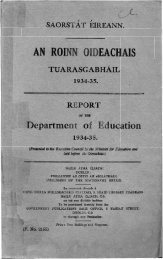1925-1926-1927 - Department of Education and Skills
1925-1926-1927 - Department of Education and Skills
1925-1926-1927 - Department of Education and Skills
- No tags were found...
Create successful ePaper yourself
Turn your PDF publications into a flip-book with our unique Google optimized e-Paper software.
28The average age at which the children are first admitted toschools would appear to lie between the ages <strong>of</strong> four <strong>and</strong> five,but in many cases they come in earlier, particularly during thelate spring <strong>and</strong> summer months. These young children are frequentlykept at home during the winter, or the greater part <strong>of</strong>it; <strong>and</strong> it is not very uncommon, especially in the Monaghan area,to find a different set <strong>of</strong> pupils in winter from those <strong>of</strong> the spring<strong>and</strong> summer months. Where the school is distant from thehomes the children are <strong>of</strong>ten not sent to school until they areseven or eight years <strong>of</strong> age.The average age at which the pupils finally left school priorto the School Attendance Act would appear to have been thirteen,but in many cases they continued to attend, especially where theinstruction was very efficient, up to the age <strong>of</strong> 14 or 15. It isfairly common to find children <strong>of</strong> 14 to 16 years returning toschool for the winter months after their period <strong>of</strong> spring <strong>and</strong>summer labour.In the poorer localities many <strong>of</strong> the children appear to be somewhatunderfed, but apart from this, the general health <strong>of</strong> theschool-going children is good. It is to be observed, however, thatepidemic sickness is prevalent in the winter <strong>and</strong> early spring, <strong>and</strong>that many schools had to close at various times during the pasttwo years on account <strong>of</strong> outbreaks <strong>of</strong> whooping-cough, measles,diphtheria <strong>and</strong> scarlet fever.(3) There are 1,160 ordinary national teachers in the Division.The great majority (862) are efficient, 169 are highly efficient,<strong>and</strong> 129 are non-efficient. The teachers as a body are competent,<strong>and</strong> they discharge their duties with diligence <strong>and</strong> efficiency. Agood number, consisting more especially <strong>of</strong> middle-aged <strong>and</strong> oldermen <strong>and</strong> women, are not qualified to teach Irish successfully, butthe number is, for various reasons, diminishing year by year. Theyoung trained teachers are in general doing useful work, butmany <strong>of</strong> them take some time to become thoroughly efficient Inthe practical side <strong>of</strong> their pr<strong>of</strong>ession.There is no reliable evidence as to the extent <strong>of</strong> private studyamong the teachers, but books dealing with Irish, Mathematics,History, Methods, etc., are <strong>of</strong>ten to be found in the schools, <strong>and</strong>from this it may be inferred that a certain amount <strong>of</strong> time isdevotedto the study <strong>of</strong> these branches. It is at least certain thatthe great majority are anxious to become pr<strong>of</strong>icient in Irish, <strong>and</strong>that many attend weekly classes, <strong>of</strong>ten at considerable inconvenience.An increasing number are providing themselves withsome<strong>of</strong> the more recent text-books which treat <strong>of</strong> modern methods<strong>of</strong> teachingmathematics.Comparatively few cases have come under my notice whereteachers have shown any special interest in folk-lore or in localhistory or literature; dearth <strong>of</strong> suitable <strong>and</strong> cheap text-books maypartly account for this. Even local industries, farming, the


